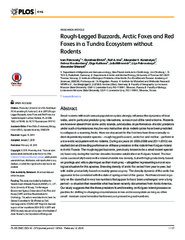Rough-legged buzzards, arctic foxes and red foxes in a tundra ecosystem without rodents
Permanent link
https://hdl.handle.net/10037/8652Date
2015-02-18Type
Journal articleTidsskriftartikkel
Peer reviewed
Author
Pokrovsky, Ivan; Ehrich, Dorothee; Ims, Rolf Anker; Kondratyev, Alexander V.; Kruckenberg, Helmut; Kulikova, Olga; Mihnevich, Julia; Shienok, AlexanderAbstract
Small rodents with multi-annual population cycles strongly influence the dynamics of food
webs, and in particular predator-prey interactions, across most of the tundra biome. Rodents
are however absent from some arctic islands, and studies on performance of arctic predators
under such circumstances may be very instructive since rodent cycles have been predicted
to collapse in a warming Arctic. Here we document for the first time how three normally rodent-dependent
predator species—rough-legged buzzard, arctic fox and red fox – perform in
a low-arctic ecosystem with no rodents. During six years (in 2006-2008 and 2011-2013) we
studied diet and breeding performance of these predators in the rodent-free Kolguev Island
in Arctic Russia. The rough-legged buzzards, previously known to be a small rodent specialist,
have only during the last two decades become established on Kolguev Island. The buzzards
successfully breed on the island at stable low density, but with high productivity based
on goslings and willow ptarmigan as their main prey – altogether representing a novel ecological
situation for this species. Breeding density of arctic fox varied from year to year, but
with stable productivity based on mainly geese as prey. The density dynamic of the arctic fox
appeared to be correlated with the date of spring arrival of the geese. Red foxes breed regularly
on the island but in very low numbers that appear to have been unchanged over a long
period – a situation that resemble what has been recently documented from Arctic America.
Our study suggests that the three predators found breeding on Kolguev Island possess capacities
for shifting to changing circumstances in low-arctic ecosystem as long as other
small - medium sized terrestrial herbivores are present in good numbers.


 English
English norsk
norsk